#venenosaurus
Explore tagged Tumblr posts
Text




#my art#paleoart#paleo art#dinosaur#venenosaurus#archelon#pterosaur#quetzalcoatlus#quadrops#paleolites
10 notes
·
View notes
Text
Dinosaur nerding about the Lifers
Since all the support for raptor Etho and an anon ask, I've been trying desperately to assign dinosaurs to all the Lifers and I cannot tell you how difficult it is to choose. I have to spend like a full 24 hours of deep thought and research on this lmao. And there are so many insanely cool dinosaurs whose names/appearances would be so awesome as added symbolism and stuff but I just cant use them all aghhh
Just some that I'll have to miss out on: I cannot assign the dinosaur "Brontomerus" to anyone but its name means "thunder thighs" and I never stop thinking about it Another funny name is Huehuecanauthlus which means "ancient duck". Also "huehue" lol love that "Aviatyrannis" means grandma tyrant which made me think of Cleo but its tiny in size "Venenosaurus" is really neat because you'd probably picture a venomous little terror but no, it's a gentle giant... "Yi Qi" is just a really fucking cool and unique dinosaur. It looks more like a proper bat than anything "Changmiania" comes from a phrase meaning "eternal sleep" due to it having a perfectly preserved skeleton of itself curled up nice and cozy in its burrow... "Anurognathidae" just google and look at this fine thing Therizinos are some of my favorite dinosaurs and there is one called "Erlikosaurus" meaning "Erlik's lizard", Erlik the god of the Underworld. That's metal as fuck but even if I manage to squeeze a Therizino into the roster, it's not gonna be Erlikosaurus because jesus christ who would that be..?? In similar vein there are two other dinos with really interesting names "Stygimoloch" and "Theiophytalia". Stygmoloch more or less means demon of the styx river, the river of the underworld etc. It's also a god's daughter or something but uhh irrelevant. I might use that one for Martyn because of the whole watcher thing idk it makes sense to me, especially with him in LL. Also it's a pachy (the dinosaur with a hardened tough head that bonks others) which I like the image of for Martyn lol Then there's Theiophytalia meaning "Belonging to the garden of Gods" whoah. I've been really struggling with Scott because he's such a hashtag deep character but I might just assign him that one. Almost like he named himself... It's an Iguanadon looking dinosaur which I think a lot of people would regard as the most basic, boring type of dinosaur (not me I love them a lot!!) but that further fits Scott but if I delve into my thoughts further we'll be here all day
I'm not gonna be able to make decisions I'm happy with for all of them anytime soon but I'll get back to you with some more dinosaur hybrid doodles for some of them!! I'm trying to represent all the major uhh families? Of dinosaurs? Like I wanna make sure there's at least one ceratops and one ankylosaur and one long-neck and one apex predator (just one. I hate apex predators lol but I'll do one for Cleo she deserves to be one) etc etc
23 notes
·
View notes
Text
Monday Musings: Macronaria
If you have been following my posts this month you will recall the one I did on sauropod phylogeny at the beginning. Today I am going to focus on one clade: macronaria. The name "macronaria" means "large nose" referring to the large nasal opening in their skulls.
These sauropods first appeared in the middle Jurassic about 168-161 Ma and lasted all the way until the extinction of the non-avian dinosaurs in the late Cretaceous. They have been found on every continent except Antarctica.
In review, here are the characteristics or synapomorphies we use to diagnose macronarian sauropods:
Middle and posterior neural spines have distal ends that extend out transversely.
Posterior neural spines extend at the tip forming a triangular process upwards.
The anterior chevrons have an open proximal articulation.
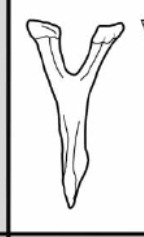
Robust, spatulate, broad-crowned teeth.
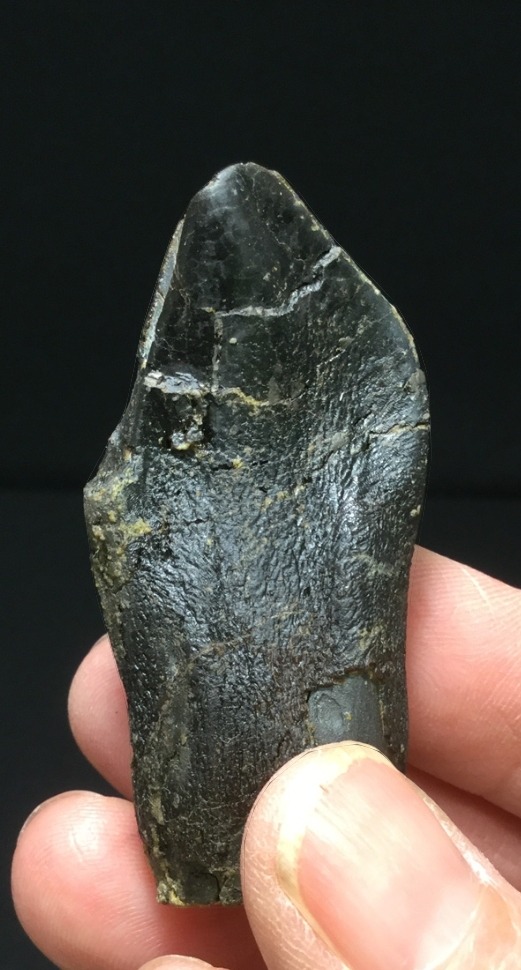
Crests formed by large, protruding nasal.
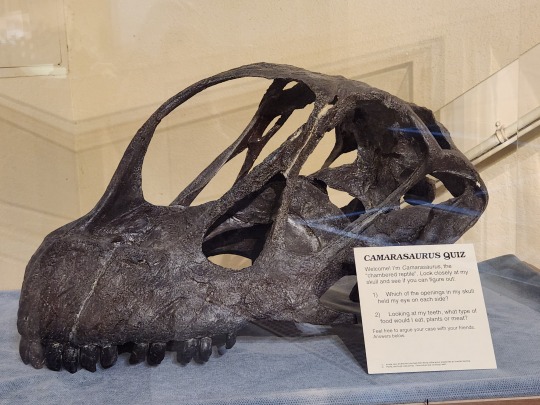
Elongate metacarpals.
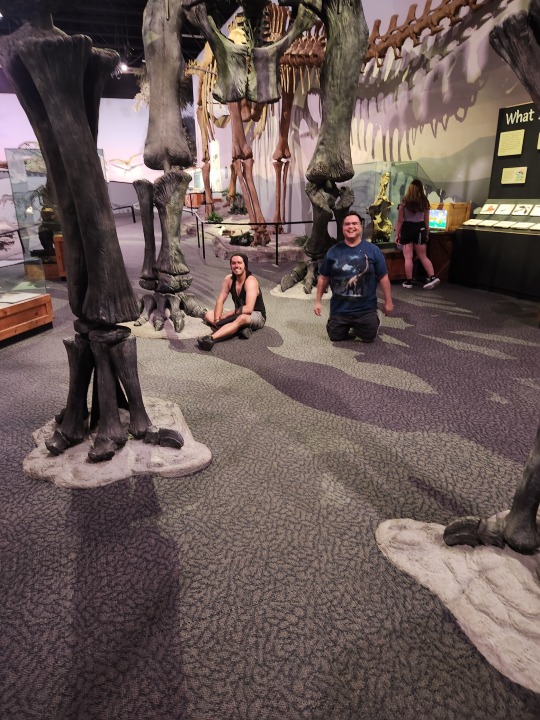
Forelimbs longer than hindlimbs.
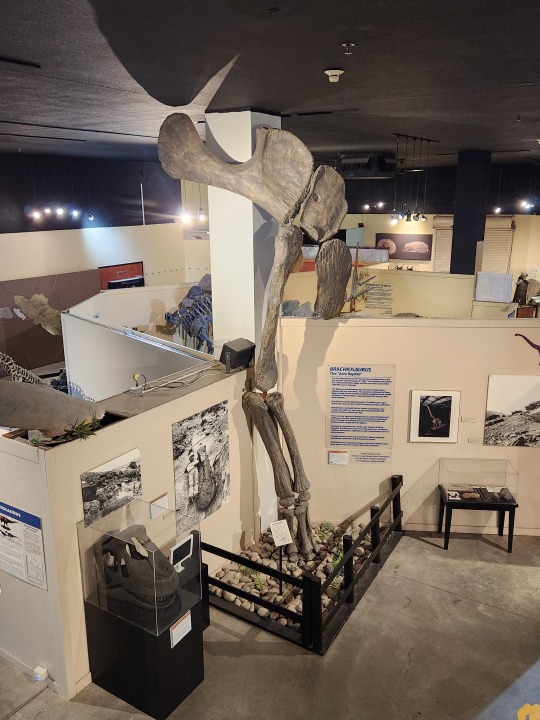
Now here's a list of important or interesting macronarians:
ABROSAURUS
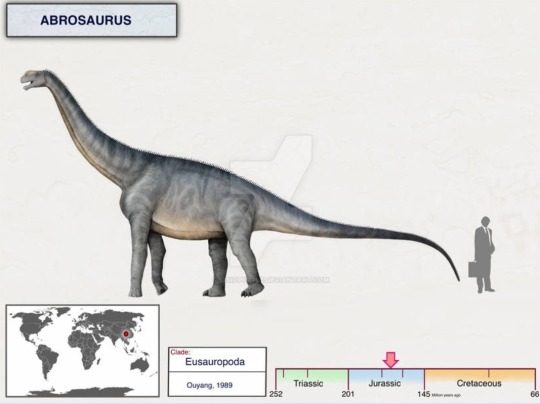
Discovered in 1984 near Zigong, China. It's name means "delicate lizard". It is from the middle Jurassic so one of the earliest in the clade and it is known from a nearly complete skull which is almost unheard of in sauropods.
AUSTRALOTITAN
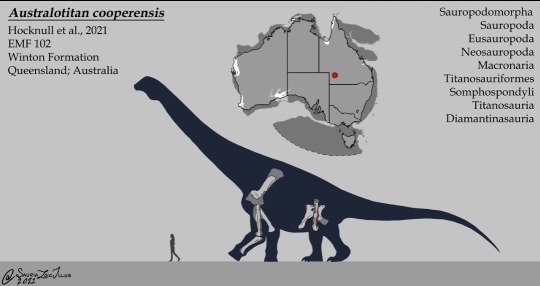
Discovered in 2005 in Queensland, Australia, the "southern giant" is the largest dinosaur found on the island continent.
CAMARASAURUS
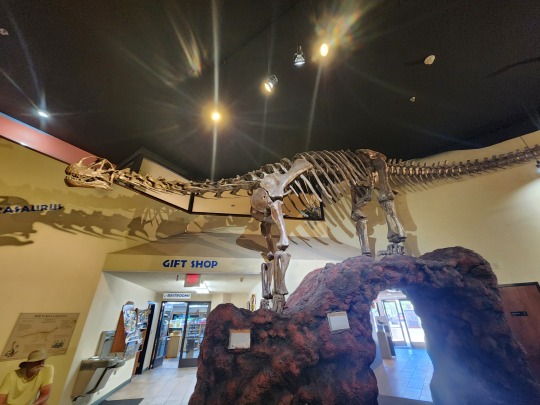
Found during the infamous Bone Wars, it is the most common sauropod in the Morrison Formation. Named in 1877 by Edward Drinker Cope, it means "chambered lizard". The first specimen was recovered from Cañon City, Colorado's Garden Park Quarry. Other specimens have come from Como Bluff, Wyoming; Fruita, Colorado; Dinosaur National Monument, Black Mesa, Oklahoma; South Dakota, New Mexico, and the Snowy Mountains of Montana. Over 500 specimens are known from both juvenile and adult animals. In fact, the most complete sauropod ever found was a juvenile Camarasaurus. You've probably seen it.

There are four species recognized: C. grandis, C. lewisi, C. lentus, and C. supremus. Stratigraphic evidence suggests an evolutionary progression of the genus through the Morrison Formation. C. grandis is the oldest occurring in the lower Salt Wash Member. It coexisted briefly with C. lewisi in the upper Salt Wash and with C. lentus in the lower Brushy Basin Member before vanishing. C. lentus continued till the bottom of the upper Brushy Basin where it briefly overlapped with C. supremus. This immediate succession of species as well as similarities suggests that C. supremus evolved directly from C. lentus.
EUHELOPUS
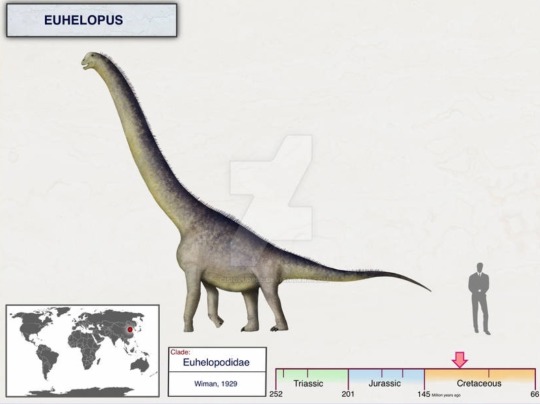
It was discovered in 1913 by a Catholic priest names Father R. Mertens and was the first dinosaur scientifically investigated in China.
FUKUITITAN
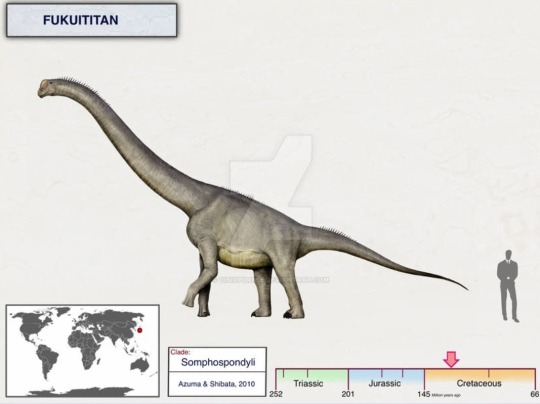
Described in 2010, this titanosaur from Japan is just fun to say.
LOURINHASAURUS

A camarasaurid found in Portugal in 1949. It comes from onw of the Morrison's sister formation, the Lourinha. It is incredibly similar to Camarasaurus with slightly longer front limbs.
VENENOSAURUS
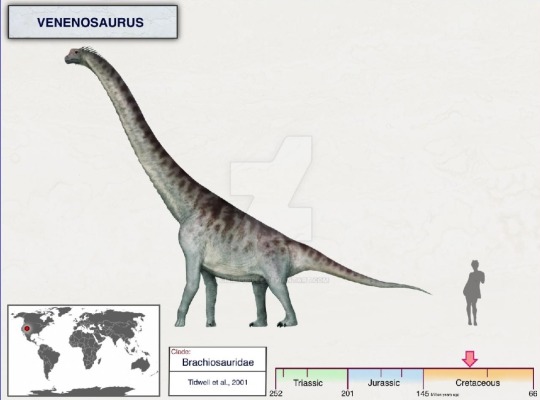
A brachiosaurid from the early Cretaceous Cedar Mountain Formation. An adult and juvenile were found in 1998 in the Poison Strip Member.
ABYDOSAURUS
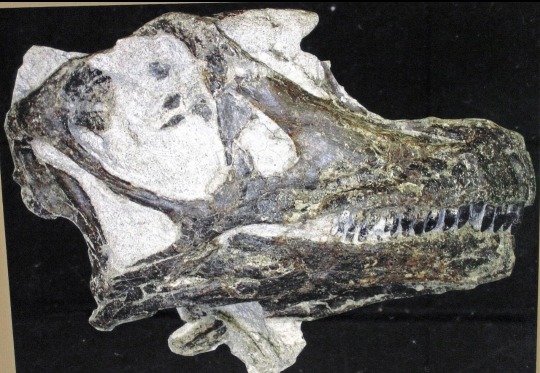
A brachiosaurid known from a complete skull. Found in the Mussentuchit Member of the Cedar Mountain Formation in Dinosaur National Monument, it was very similar to Giraffatitan with narrower teeth and a smaller nose.
BRACHIOSAURUS
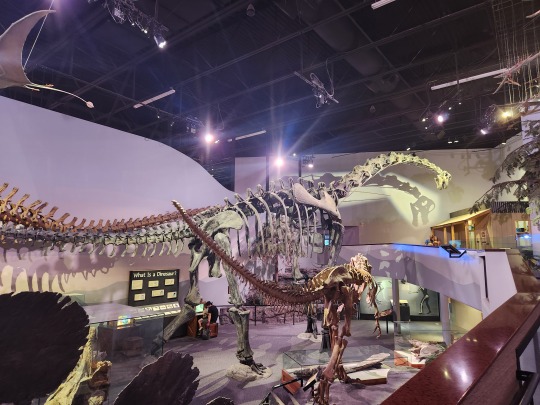
Found during the Bone Wars in 1900 by Elmer Riggs in Fruita, Colorado, it was the largest dinosaur ever found at the time. Despite it's popularity though, very little is actually known about this dinosaur.
CEDAROSAURUS
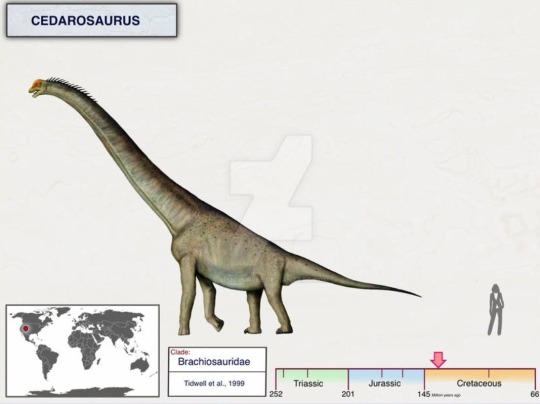
Another brachiosaurid found in the Cedar Mountain Formation but in the Yellow Cat Member. Seems brachiosaurids lasted a bit in North America.
EUROPASAURUS
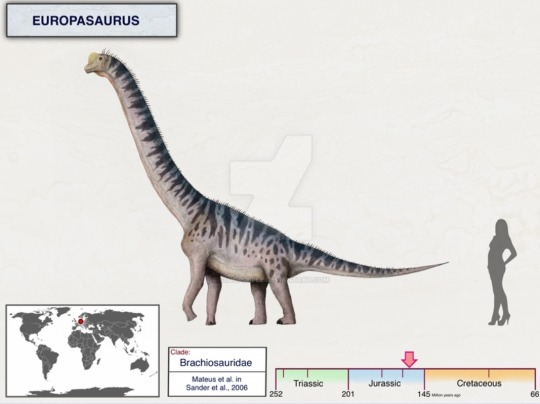
A brachiosaurid from late Jurassic Germany, it was identified as an example of insular dwarfism resulting from isolation on an island. It was only 20ft (6.2m) long!
GIRAFFATITAN
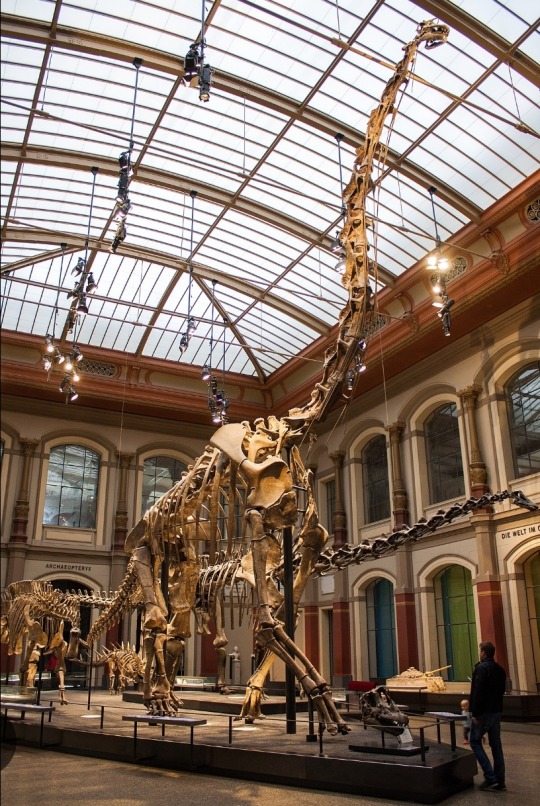
A brachiosaurid from the other Morrison sister formation, the Tendaguru. Once thought to be a species of Brachiosaurus, most reconstructions are actually based on this genus. It is the largest sauropod known from relatively complete material. The mounted specimen in Berlin is actually a subadult at about 73.7ft (22.46m) long and 40ft (12m) tall.
ARGENTINOSAURUS
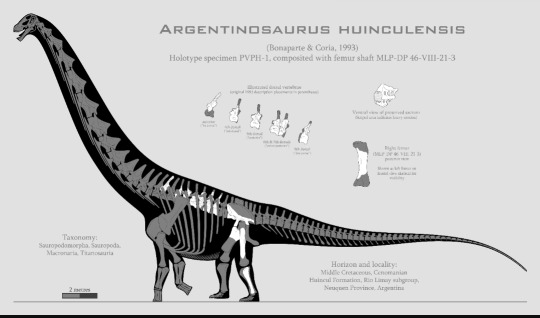
A titanosaur from late Cretaceous Argentina, it is often considered the largest sauropod ever but with so little to go off that really is a bit of a leap. We need more skeletal remains.
ALAMOSAURUS

The only titanosaur found in North America. Remains have been recovered in Texas, Utah, New Mexico, and possibly Wyoming. Despite it's name, it was actually found in New Mexico first. This one is probably kore accurately the largest sauropod as we have more material.
#paleontology#fossils#dinosaur#fun facts#sauropod#Macronaria#brachiosaurus#camarasaurus#giraffatitan#argentinosaurus#alamosaurus
11 notes
·
View notes
Note
Nobody told me taeyong's fish gave birth and I'm like

Why did nobody told me?!
wha-- lee taeyong?? korean idol and single father of 22?? his pet fish just gave birth? im so confused. what
9 notes
·
View notes
Photo

Venenosaurus, Supposedly.
Taken from: http://www.animalesprehistoricos.com/2009/11/venenosaurus.html
45 notes
·
View notes
Photo

VENENOSAURUS “Poison lizard” Early Cretaceous, 112 million years ago
This “poison lizard” is known only from incomplete remains of one adult and one juvenile, but was probably small for a titanosaur (only 33 feet long). There is no evidence that it was poisonous, however; instead, its name comes from the place it was found – the “Poison Strip” section of Utah's Cedar Mountain Formation – which was, in turn, named after the 80's glam metal band, not the high arsenic content of the soil there. The name Venenosaurus was also chosen to highlight the dinosaur's embarrassing stutter.
#saddinosaurfacts#dinosaur#dinosaurs#venenosaurus#sauropod#sauropods#sauropodomorpha#sauropodmorphs#sauropodomorph#titanosaur#titanosaurs#utah#poison#this one isn't that good#sorry#cretaceous
126 notes
·
View notes
Text
Utahraptor ostrommaysi
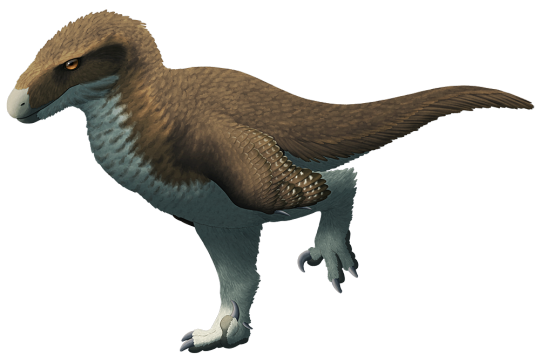
By Nix, CC BY-NC 4.0
Etymology: Thief from Utah
First Described By: Kirkland et al., 1993
Classification: Dinosauromorpha, Dinosauriformes, Dracohors, Dinosauria, Saurischia, Eusaurischia, Theropoda, Neotheropoda, Averostra, Tetanurae, Orionides, Avetheropoda, Coelurosauria, Tyrannoraptora, Maniraptoromorpha, Maniraptoriformes, Maniraptora, Pennaraptora, Paraves, Eumaniraptora, Dromaeosauridae, Eudromaeosauria, Dromaeosaurinae
Status: Extinct
Time and Place: Between 129 and 120 million years go, from the Barremian to the Aptian ages of the Early Cretaceous


Utahraptor is known from the Yellow Cat and Poison Strip members of the Cedar Mountain Formation
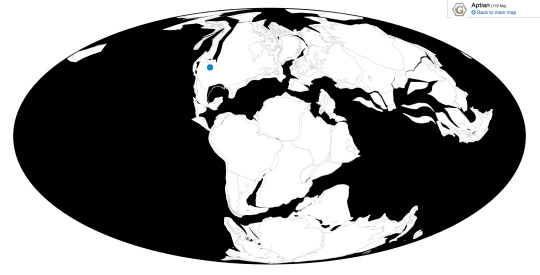
Physical Description: Utahraptor was a very large raptor dinosaur, and had the associated bodily characteristics - a bulky trunk, shorter legs, long arms, large head, and long, stiffened tail. It was really and truly huge, about 7 meters long and 500 kilograms in weight - about the size of a modern Grizzley or Polar Bear, though they might have been heavier than previously thought. Like other raptors, it had huge sickle claws on its feet, and the claws were probably around 24 centimeters long - or even longer, if they had been covered in a keratin sheath as potentially thought. The skull of Utahraptor has not yet been described, so for now we can only say that it had a long, triangular head like other raptors, with sharp serrated teeth. As with other raptors, it would have been feathered - with very large wings for flapping, and a distinctively huge tail fan. The legs of Utahraptor would have been slightly less feathered, but still distinctive. In short, it was a big and fluffy bird-bear, and the largest predator in its environment.

By Matt Martyniuk, CC BY-SA 3.0
Diet: Utahraptor was a large predator and, accordingly, ate large sources of food such as ornithopods and younger sauropods.
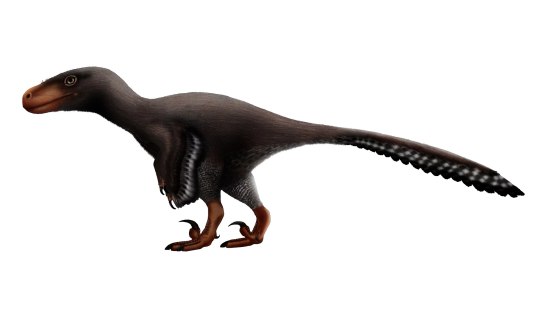
By PaleoNeolitic, in the Public Domain
Behavior: As a raptor, Utahraptor would have been most analogous to a cat - probably stalking alone rather than in packs, and utilizing ambush behavior to trap its prey. Since it had somewhat stubby legs and wasn’t very fast at all, it couldn’t have relied on pursuit to attack its food, even if its food was just as slow as it was. Instead, these powerful legs helped Utahraptor to jump onto its food and surprise it, even from the ground where it spent its time. It then could use raptor prey restraint (RPR) to stay balanced on the prey, flapping its wings rapidly as the prey moved around and tried to escape. Those impossibly large sickle claws then were used to strategically stab at places where the prey would bleed out - important veins and arteries - rather than slash. In addition to this, Utahraptor would have been able to flap its wings rapidly and run up steep surfaces - a technique called Wing-Assisted Inclined Running (WAIR) - even vertical ones, like cliff faces and trees. This allowed Utahraptor to reach strategic vantage points and search for prey - and even jump down onto it from high heights. These techniques allowed Utahraptor to not only hunt the similarly-sized Ornithopods of the time, but also potentially attack the even larger Sauropods with which it shared its home. When it needed a smaller snack, that large claw could be used to pin down struggling furry mammals and lizards, in order for Utahraptor to then take a bite.
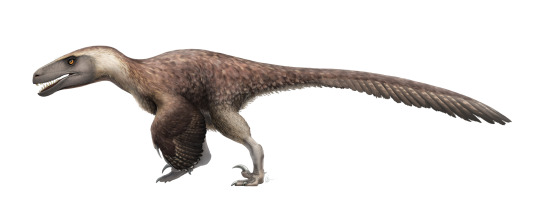
By Fred Wierum, CC By-SA 4.0
Though Utahraptor did not hunt in packs, that doesn’t mean it wasn’t social - and, indeed, there is considerable evidence not yet described that it lived in dense family groups. This would probably mean that adult Utahraptor would go out hunting on their own, while the little ones would gather their own food, before coming together in the same space for safety from other Utahraptor and just to spend the night. It is very likely that Utahraptor took care of its own young based on its relatives - and there’s hopefully more evidence on the way to corroborate this. This was a very complex social animal, using those fancy wings and tail fan to display to other Utahraptor - by holding up the wings and lifting the tail fan to display, it could communicate with others that it was a threat, that it wanted to mate, or to stay away from its nest. In general, it would have behaved very bird-like - walking around, bobbing its head, and moving its head to look for food and for each other rather than moving the eyes. And, like birds, it would have been very active, and warm-blooded.
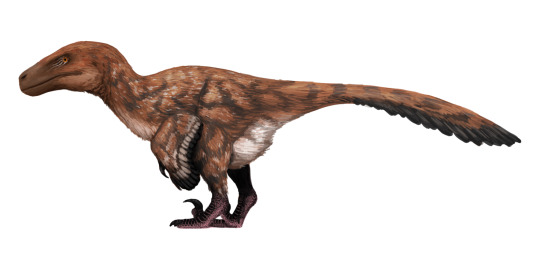
By Ashley Patch
Ecosystem: When the Cedar Mountain Formation supported Utahraptor, it was a very large floodplain environment, that periodically flash flooded and filled the valley with mud. This was a seasonally wet environment with a variety of rivers, forests, prairies, and open woodlands. The ecosystem had a short wet system and a very long, tedious dry season. Utahraptor shared this environment with countless creatures - the tuataran Toxolophosaurus, the turtle Glyptops, a variety of fish, the mammaliaform Cifelliodon, and - of course - other dinosaurs. There was the ankylosaur Gastonia, the large Iguanodon-like Ornithopods Cedrorestes, Hippodraco, and Iguanacolossus; the Sauropods Cedarosaurus and Mierasaurus; the Therizinosaurs Martharaptor and Falcarius; the Troodontid Geminiraptor; the Ornithomimosaur Nedcolbertia; and another raptor - Yurgovuchia! This gave Utahraptor a wide variety of things to hunt in its environment.
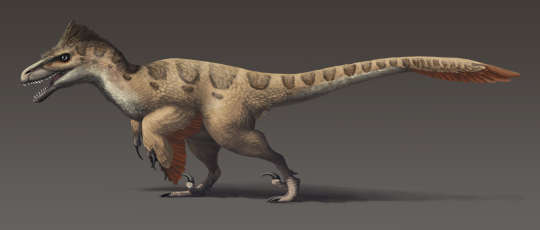
By Emily Willoughby, CC By-SA 3.0
By the time of the later Poison Strip environment, things were changing rapidly in Cedar Mountain. Dry seasons were longer now, and a significant amount of sand was washing through the ecosystem. This made life higher in the floodplain, and probably eliminated many of the forests and river-woods that had been present prior to, leaving only a somewhat scrubland-esque plain. Accordingly, creature diversity actually went down - it was something of an ecosystem collapse. There was still food for Utahraptor to eat - the Ornithopod Planicoxa, and the sauropods Moabosaurus and Venenosaurus; but that was it. Utahraptor, thus, was living in a miniature extinction event - and disappears from the environment by the time the mud and rainy seasons returned in the Ruby Ranch Environment, and the large predator niche was replaced by the carnosaur Acrocanthosaurus.

By Calum O’Halloran
Other: Utahraptor was the largest raptor known, and we actually have many fossils of it - but they’re trapped in a block! Well, there isn’t funding to remove them from the block, anyway. So much more could be (and will be, dammit!) written about this excellent dinosaur if it was adequately funded to be researched properly. Check out the Utahraptor Project if you want to learn more about Utahraptor - and consider donating! Literally every penny helps. Utahraptor is also one of the inspirations for the raptors of Jurassic Park, along with Deinonychus - though, obviously, those creatures do not resemble their real counterparts in the slightest.
~ By Meig Dickson
Sources under the Cut
Apesteguía, S., S. de Valais, G. R. Cordero and O. M. Ramírez. 2011. New ichnological record from the late Campanian Toro Toro Formation at Toro Toro, Potosí (Bolivia): first probably dromaeosaurid tracks from South America. Ameghiniana 48(4):662-667
Aubrey, W.M. 1998. A newly discovered, widespread fluvial facies and unconformity marking the Upper Jurassic/Lower Cretaceous boundary, Colorado Plateau. Modern Geology, v. 22, p. 209-233.
Barco, J. L., and J. I. Ruiz-Omeñaca. 2001. Primeros dientes de terópodo (Dinosauria, Saurischia) en la Formación Villar del Arzobispo (Tithónico-Berriasiense): yacimientos Cuesta Lonsal y Las Cerradicas 2 (Galve, Teruel) [First teeth of a theropod (Dinosauria, Saurischia) in the Villar del Arzobispo Formation (Tithonian–Berriasian): Cuesta Lonsal and Las Cerradicas 2 localities (Galve, Teruel)]. In G. Meléndez, Z. Herrera, G. Delvene & B. Azanza (eds.), XVII Jornadas de la Sociedad Española de Paleontología. Los Fósiles y la Paleogeografía. Ayuntamiento de Albarracín y Fundación Conjunto Paleontólogico de Teruel, Albarracin, Spain 5.1:239-246
Campione, N. E., D. C. Evans, C. M. Brown, M. T. Carrano. 2014. Body mass estimation in non-avian bipeds using a theoretical conversion to quadruped stylopodial proportions. Methods in Ecology and Evolution 5 (9): 913 - 923.
Carpenter, K. 1998. Evidence of predatory behavior by carnivorous dinosaurs. Gaia 15: 135 - 144.
Carpenter, K. 2002. Forelimb biomechanics of nonavian theropod dinosaurs in predation. Senckenbergiana Lethaea 82: 59 - 76.
Carpenter, K., 2006, Assessing dinosaur faunal turnover in the Cedar Mountain Formation (Lower Cretaceous) of eastern Utah, USA. Ninth International Symposium on Mesozoic Terrestrial Ecosystems and Biota, Abstract and Proceedings Volume, p. 21-25.
Carpenter, Kenneth; Bartlett, Jeff; Bird, John; Barrick, Reese (2008). "Ankylosaurs from the Price River Quarries, Cedar Mountain Formation (Lower Cretaceous), east-central Utah". Journal of Vertebrate Paleontology. 28 (4): 1089–1101.
Chure, Daniel; Britt, Brooks; Whitlock, John A.; Wilson, Jeffrey A. (2010). "First complete sauropod dinosaur skull from the Cretaceous of the Americas and the evolution of sauropod dentition". Naturwissenschaften. 97 (4): 379–91.
Cifelli, R. L., Nydam, R. L., Gardner, J. D., Weil, A., Eaton, J. G., Kirkland, J. I., and Madsen, S., 1999, Medial Cretaceous vertebrates from the Cedar Mountain Formation, Emery County, Utah: the Mussentuchit Local Fauna, in, Gillette, D., Vertebrate Paleontology in Utah. Utah Geological Survey Miscellaneous Publication 99-1, p. 219-242.
Britt, B. B., K. L. Stadtman, and R. D. Scheetz. 1996. The Early Cretaceous Dalton Wells dinosaur fauna and the earliest North American titanosaurid sauropod. Journal of Vertebrate Paleontology 16(3, suppl.):24A
Britt, B. B., and K. L. Stadtman. 1997. Dalton Wells Quarry. In P. J. Currie & K. Padian (ed.), Encyclopedia of Dinosaurs 165-166
Britt, B. B., D. A. Eberth, R. D. Scheetz, B. W. Greenhalgh, and K. L. Stadtman. 2009. Taphonomy of debris-flow hosted dinosaur bonebeds at Dalton Wells, Utah (Lower Cretaceous, Cedar Mountain Formation, USA). Palaeogeography, Palaeoclimatology, Palaeoecology 280:1-22
Burnham, D. A., P. Senter, R. Barsbold and B. B. Britt. 2004. Phylogeny of the Dromaeosauridae. Journal of Vertebrate Paleontology 24(3, suppl.):42A
Currie, P. J. 1995. New information on the anatomy and relationships of Dromaeosaurus albertensis (Dinosauria: Theropoda). Journal of Vertebrate Paleontology 15(3):576-591
Currie, P. J. 1997. Dromaeosauridae. In P. J. Currie & K. Padian (ed.), Encyclopedia of Dinosaurs 194-195
Currie, P. J. 2000. Theropods from the Cretaceous of Mongolia. In M. J. Benton, M. A. Shishkin, D. M. Unwin, & E N. Kurichkin (eds.), The Age of Dinosaurs in Russia and Mongolia 434-455
DePalma, R. A., D. A. Burnham, L. D. Martin, P. L. Larson, R. T. Bakker. 2015. The first Giant Raptor (Theropoda: Dromaeosauridae) from the Hell Creek Formation. Paleontological Contributions 14: 1-16.
Dinets, V. 2014. Apparent coordination and collaboration in cooperatively hunting crocodilians. Ethology Ecology & Evolution 27 (2): 244 - 250.
Erickson, G. M., K. Curry Rogers, D. J. Varricchio, M. A. Norell, X. Xu. 2007. Growth patterns in brooding dinosaurs reveals the timing of sexual maturity in non-avian dinosaurs and genesis of the avian condition. Biology Letters 3 (5): 558 - 61.
Fowler, D. W., E. A. Freedman, J. B. Scannella, R. E. Kambic. 2011. The Predatory Ecology of Deinonychus and the Origin of Flapping in Birds. PLoS ONE 6 (12): e28964.
Frederickson, J. A., M. H. Engel, R. L. Cifelli. 2018. Niche Partitioning in Theropod Dinosaurs: Diet and Habitat Preference in Predators from the Uppermost Cedar Mountain Formation (Utah, U.S.A.). Scientific Reports 8: 17872.
Galton, P. M., and J. A. Jensen. 1975. Hypsilophodon and Iguanodon from the Lower Cretaceous of North America. Nature 257:668-669
Gauthier, J., K. Padian. 1985. Phylogenetic, Functional, and Aerodynamic Analyses of the Origin of Birds and their Flight. Hecht, M. K., J. H. Ostrom, G. Viohl, P. Wellnhofer (ed.). The Beginnings of Birds. Proceedings of the International Archaeopteryx Conference, Eichstätt: Freunde des Jura-Museums Eichstätt: 185 - 197.
Gishlick, A. D. 2001. The function of the manus and forelimb of Deinonychus antirrhopus and its importance for the origin of avian flight. In Gauthier, J., L. F. Gall. New Perspectives on the Origin and Early Evolution of Birds. New Haven: Yale Peabody Museum: 301 - 318.
Godefroit, P., P. J. Currie, H. Li, C. Y. Shang, and Z.-M. Dong. 2008. A new species of Velociraptor (Dinosauria: Dromaeosauridae) from the Upper Cretaceous of northern China. Journal of Vertebrate Paleontology 28(2):432-438
Kiernan, K., and D. R. Schwimmer. 2004. First record of a celociraptorine theropod (Tetanurae, Dromaeosauridae) from the eastern Gulf Coastal United States. The Mosasaur 7:89-93
Kirkland, J. I., D. Burge, and R. Gaston. 1993. A large dromaeosaur (Theropoda) from the Lower Cretaceous of eastern Utah. Hunteria 2(10):1-16
Kirkland, J.I., Britt, B., Burge, D., Carpenter, K., Cifelli, R., DeCourten, F., Eaton, J., Hasiotis, S., and Lawton, T., 1997b, Lower to Middle Cretaceous dinosaur faunas of the Central Colorado Plateau: a key to understanding 35 million years of tectonics, sedimentology, evolution, and biogeography. Brigham Young University Geology Studies, v. 42, p. 69-103.
Kirkland, J.I. and Madsen, S.K. (2007). "The Lower Cretaceous Cedar Mountain Formation, eastern Utah: the view up an always interesting learning curve." Fieldtrip Guidebook, Geological Society of America, Rocky Mountain Section. 1-108 p.
Kirkland, J. I., Edward L. Simpson, Donald D. DeBlieux, Scott K. Madsen, Emily Bogner & Neil E. Tibert (2016). Depositional constraints on the Lower Cretaceous Stikes Quarry dinosaur site: Upper Yellow Cat Member, Cedar Mountain Formation, Utah. Palaios 31(9): 421-439; doi: 10.2110/palo.2016.041
Kowallis, B. J., Christiansen, E. H., Deino, A. L., Peterson, F., Turner, C.E., Kunk, M. J., and Obradovich, J. D., 1998, The age of the Morrison Formation. Modern Geology, v. 22, p. 235-260.
Le Loeuff, J., and E. Buffetaut. 1998. A new dromaeosaurid theropod from the Upper Cretaceous of southern France. Oryctos 1:105-112
Longrich, N. R., and P. J. Currie. 2009. A microraptorine (Dinosauria–Dromaeosauridae) from the Late Cretaceous of North America. Proceedings of the National Academy of Sciences
Martyniuk, M. 2016. You’re Doing It Wrong: Microraptor Tails and Mini-Wings. DinoGoss Blog.
McDonald, AT, Kirkland JI, DeBlieux DD, Madsen SK, Cavin J, et al. (2010). Farke AA (ed.). "New Basal Iguanodonts from the Cedar Mountain Formation of Utah and the Evolution of Thumb-Spiked Dinosaurs". PLoS ONE. 5 (11): e14075.
Norell, M. A., and P. J. Makovicky. 2004. Dromaeosauridae. In D. B. Weishampel, P. Dodson, and H. Osmolska (eds.), The Dinosauria (second edition). University of California Press, Berkeley 196-209
Paul, Gregory S. (2016). The Princeton Field Guide to Dinosaurs (2nd Edition). Princeton, New Jersey: Princeton University Press. pp. 151, 163, 229, 252, 314, 319, 326, 327.
Pei, R., Q. Li, Q. Meng, K.-Q. Gao, and M. A. Norell. 2014. A New Specimen of Microraptor (Theropoda: Dromaeosauridae) from the Lower Cretaceous of Western Liaoning, China. American Museum Novitates 3821:1-28
Prum, R.; Brush, A.H. (2002). "The evolutionary origin and diversification of feathers". The Quarterly Review of Biology. 77 (3): 261–295.
Rauhut, O. W. M. 2003. The interrelationships and evolution of basal theropod dinosaurs. Special Papers in Palaeontology 69:1-213
Roca-Argemi, X. and Nadon, G. C. 2003. The Buckhorn Conglomerate as the upper member of the Morrison Formation: new evidence from the type section, Cedar Mountain, Utah. Geological Society of America, Rocky Mountain Section, 55th Annual Meeting, Paper 14-1.
Rothschild, B., Tanke, D. H., and Ford, T. L., 2001, Theropod stress fractures and tendon avulsions as a clue to activity: In: Mesozoic Vertebrate Life, edited by Tanke, D. H., and Carpenter, K., Indiana University Press, p. 331-336.
Ruiz-Omeñaca, J. I., and J. I. Canudo. 2003. Dinosaurios (Saurischia, Ornithischia) en el Barremiense (Cretácico Inferior) de la península Ibérica [Dinosaurs (Saurischia, Ornithischia) in the Barremian (Lower Cretaceous) of the Iberian peninsula]. In F. Pérez Lorente (ed.), Dinosaurios y Otros Reptiles Mesozóicos de España 269-312
Sanders, F.; Manley, K.; Carpenter, K. (2001). "Gastroliths from the Lower Cretaceous sauropod Cedarosaurus weiskopfae". In Tanke, Darren; Carpenter, Ken (eds.). Mesozoic Vertebrate Life: New Research Inspired by the Paleontology of Philip J. Currie. Indiana University Press. pp. 166–180.
Senter, P., R. Barsbold, B. B. Britt and D. A. Burnham. 2004. Systematics and evolution of Dromaeosauridae (Dinosauria, Theropoda). Bulletin of the Gunma Museum of Natural History 8:1-20
Senter, P., J. I. Kirkland, and D. D. DeBlieux. 2012. Martharaptor greenriverensis, a new theropod dinosaur from the Lower Cretaceous of Utah. PLoS ONE 7(8):e43911:1-12
Senter, P.; Kirkland, J.I.; Deblieux, D. D.; Madsen, S.; Toth, N. (2012). Dodson, Peter (ed.). "New Dromaeosaurids (Dinosauria: Theropoda) from the Lower Cretaceous of Utah, and the Evolution of the Dromaeosaurid Tail". PLoS ONE. 7 (5): e36790.
Shapiro, R.S., Fricke, H.C., and Fox, K. 2009. Dinosaur-bearing oncoids from ephemeral lakes of the Lower Cretaceous Cedar Mountain Formation, Utah. Palaios 2(4):51-58.
Smith, D. K. 1997. Museum of Earth Science, Brigham Young University. In P. J. Currie & K. Padian (ed.), Encyclopedia of Dinosaurs 457-458
Stokes, W. L. 1944, Morrison and related deposits in the Colorado Plateau. Geological Society of America Bulletin v. 55, p. 951-992.
Stokes, W.L. 1952. Lower Cretaceous in the Colorado Plateau. American Association of Petroleum Geologists v. 36: 1766-1776.
Sues, H.-D., and A. Averianov. 2014. Dromaeosauridae (Dinosauria: Theropoda) from the Bissekty Formation (Upper Cretaceous: Turonian) of Uzbekistan and the phylogenetic position of Itemirus medullaris Kurzanov, 1976. Cretaceous Research 51:225-240
Switek, Brian (January 7, 2015). "Utah's Dinosaur 'Death Trap' Reveals Trove of Giant Predators". National Geographic. Retrieved April 15, 2017.
Turner, A. H., S. H. Hwang, and M. A. Norell. 2007. A small derived theropod from Öösh, Early Cretaceous, Baykhangor Mongolia. American Museum Novitates 3557:1-27
Turner, Alan H.; Pol, D.; Clarke, J.A.; Erickson, G.M.; Norell, M. (2007). "A basal dromaeosaurid and size evolution preceding avian flight". Science. 317 (5843): 1378–1381.
Turner, AH; Makovicky, PJ; Norell, MA (2007). "Feather quill knobs in the dinosaur Velociraptor". Science. 317 (5845): 1721.
Weishampel, David B.; Dodson, Peter; and Osmólska, Halszka (eds.): The Dinosauria, 2nd, Berkeley: University of California Press. 861 pp.
Williamson, T. E., and S. L. Brusatte. 2014. Small theropod teeth from the Late Cretaceous of the San Juan Basin, northwestern New Mexico and their implications for understanding latest Cretaceous dinosaur evolution. PLoS ONE 9(4):e93190:1-23
Xu, X.; Zhou, Z.; Wang, X.; Kuang, X.; Zhang, F.; Du, X. (2003). "Four-winged dinosaurs from China". Nature. 421 (6921): 335–340.
#Utahraptor ostrommaysi#Utahraptor#Dinosaur#Utahraptor ostrommaysorum#Raptor#Bird#Dromaeosaur#Birds#Feathered Dinosaurs#Dinosaurs#Birblr#Palaeoblr#Factfile#Cretaceous#Carnivore#Theropod Thursday#North America#paleontology#prehistory#prehistoric life#biology#a dinosaur a day#a-dinosaur-a-day#dinosaur of the day#dinosaur-of-the-day#science#nature
726 notes
·
View notes
Note

👁👄👁
yes because i’d actually do this
i VALUE my beauty sleep
4 notes
·
View notes
Note
ngl kingdom stresses the fuck out of me
So I stopped watching, I'll watch when everything is over to reduce emotional damage
You watch kingdom?
ive watched a few episodes but most of the performances are pretty overhyped. i did like ateez's wonderland pirate thing though
2 notes
·
View notes
Note
out of all your moots who’d you sing dino abc with?
I JUST GOT AROUND TO ANSWERING THIS BUT
@hyuckster (liaoceratops)
@freemefromfigureskating (venenosaurus)
@oifelixcmerebrou (rinchenia)
@jaehyunsssslut (bellusaurus)
lets do it guys
#SING DINOSAURS A TO Z#i tried to put dinosaurs that sound like your names???#but it was harder than i thought#dino abc#asks#hyuckster 💎
8 notes
·
View notes
Text
Venenosaurus dicrocei

Source: http://dinopedia.wikia.com/wiki/Venenosaurus
Name: Venenosaurus dicrocei
Name Meaning: Poison Reptile
First Described: 2001
Described By: Tidwell et al.
Classification: Dinosauria, Saurischia, Eusaurischia, Sauropodomorpha, Plateosauria, Massopoda, Sauropodiformes, Anchisauria, Sauropoda, Gravisauria, Eusauropoda, Neosauropoda, Macronaria, Titanosauriformes, Brachiosauridae
Venenosaurus is another brachiosaurid, known from two skeletons, a juvenile and an adult, though both were incomplete. It was fairly small, only about 10 meters long; it was found in the Poison Strip Member of teh Cedar Mountain Formation in Grand County, Utah. It lived about 112 million years ago, in the Albian age of the Early Cretaceous. It was similar to Cedarosaurus, though distinct.
Source:
https://en.wikipedia.org/wiki/Venenosaurus
Shout out goes to freshmevelyn!
#venenosaurus#venenosaurus dicrocei#dinosaur#sauropod#prehistoric life#paleontology#prehistory#dinosaurs#biology#a dinosaur a day#a-dinosaur-a-day#dinosaur of the day#dinosaur-of-the-day#science#nature#factfile#freshmevelyn
27 notes
·
View notes